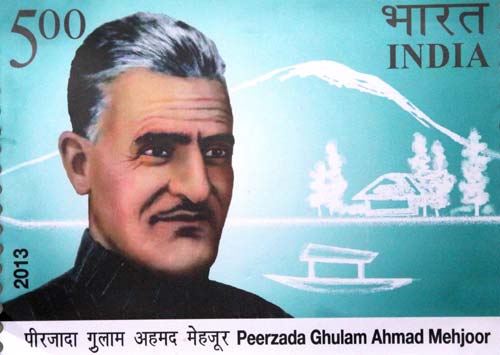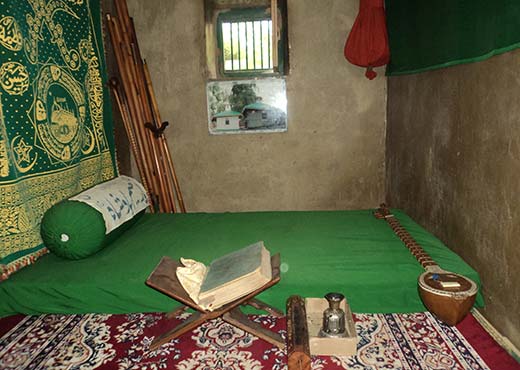Learning a lesson from the obscure poets of Kashmir, Peerzada Nadeem Mehjoor, Ghulam Ahmed Mahjoor’s great-grandson, a school drop-out with a conscious mind is planning to preserve the poet’s work and collection. Syed Asma reports
The rest of the restaurant is empty and a group of four youngsters is seen sitting at a corner table. Their words, Mehjoor…culture… poet…poetry… Kashmir is echoing all over the place. Group of four, three boys and a girl, look enthusiastic! They describe themselves as ‘art-lovers. Two of them are academically medical doctors and the girl is a student of library science and the other guy, sitting quietly, is Peerzada Nadeem Mahjoor – great-grandson of Peerzada Ghulam Ahmed Mehjoor.
Though ‘Mehjoor’ is the poet’s pen-name which usually cannot be inherited but their family has passed it to the next generations, interestingly, even their daughters-in-law inherit the poet’s pen-name.
Among the four in the restaurant, Nadeem and the girl, Rabia – a student of Library Science, are working on creating an institution under the name of Peerzada Ghulam Ahmed Mehjoor, in the University of Kashmir. Mehjoor is also famous as Shahyr-i-Kashmir’. The duo explains it as their dream project.
The project ‘Institution Mehjoor’ is in its final stage, says Nadeem, ill-health of one of the authorities in the university is delaying the project a bit.
He is planning to build up a research centre in Mehjoor’s name apart from displaying Mehjoor’s work and collections.
He adds, the project is his brainchild and he wants Mehjoor to live forever in Kashmir, as an institution. “I won’t let him die ever.”
“I don’t want him [Mehjoor] to be Gani Kashmiri of the valley. I want his work, collections, memoirs, belongings to be displayed among the public. So, he is remembered by the people in the ages to come.”
Nadeem, a twenty-eight-year-old young man, is living with his mother in the house build by Ghulam Ahmed Mahjoor in Metragam, Pulwama. “It was then a Shahi house and is built by Mehjoor, the poet, himself,” Nadeem says.
Nadeem a school drop-out has consciously taken up a project to preserve Mehjoor’s work.
“What I have realized is that over the years we have surrendered all our treasures, I do not want to do that. Though I am getting a good price but I believe all his work and collections are priceless.”
Nadeem’s wants to build a museum in name of Ghulam Ahmed Mehjoor as is of William Shakespeare in England.
Though Nadeem has not continued his studies after his father died but he says he has read and almost remembers every bit from the literature his father has passed on to him. The literally is mostly Mehjoor’s own collection.

Nadeem’s father Mohammed Amin Mehjoor, was a school teacher and a writer. Amin was eighteen years old when Mehjoor passed away. Nadeem says, “He [Amin] was the only grandson of Mehjoor who has met him and has spent time with him. He adds with a smirk, “and I am his [Amin’s] son. He passed it all to me.”
He adds, “I have not touched a single thing in his [Mehjoor’s] room. I believe it is in a similar way as Mehjoor has left because my father had taken a promise not to touch anything.”
It is a small room with mud-clay walls and a single window opening. In a corner is a bunch of wooden staffs, belonging to Mehjoor and a Santoor is placed in another. Everything is placed like this for years, Nadeem says.
The family besides the political leaders have been proposing for years that the house of the poet should get the status of a National monument. Even Saifud din Soz in a ceremony of stamp release of the poet last year proposed the same. The ceremony was attended by the then Prime Minister Manmohan Singh.
“Mehjoor was a music listener, an extensive reader and a traveller,” Nadeem says.
The collection which Nadeem possesses and wishes to display in his upcoming project at the University of Kashmir include 700 years old handwritten Holy Quran, 300 years old Hafiz Sheerazi’s handwritten books, 300 years Alexander’s biography, Mehmood Ghami’s handwritten book- ‘Laila Majnoon’. Apart from literature, their collection includes utensils as old as Budshah’s era and many other things.
Besides, a portion of Nadeem’s collection suggests that Mehjoor was a well-off man in the state of Jammu and Kashmir.
The collection includes foreign-made clothes, temperature scales, stylish hookah’s, musical instruments. “Though he did not travel to Germany, France and England but it shows the acquaintances he has and the lifestyle he had,” says Nadeem.
The multi-lingual poet belonged to a humble but educated family. His father was a scholar of the Persian language and his mother had passed away when he was one and a half-year-old.
After passing the middle school examination from Nusrat-ul-Islam School, Srinagar, he went to Punjab where he came in contact with Urdu poets like Bismil Amritsari and Moulana Shibi Nomani. There he worked as a newspaper hawker.
He returned to Srinagar in 1908 and started writing in Persian and then in Urdu.
Apart from being a well-known poet, Mehjoor has been a Patwari during the tenure India was under British rule. But Nadeem says Mehjoor has not preserved much of his works as a Patwari.
















